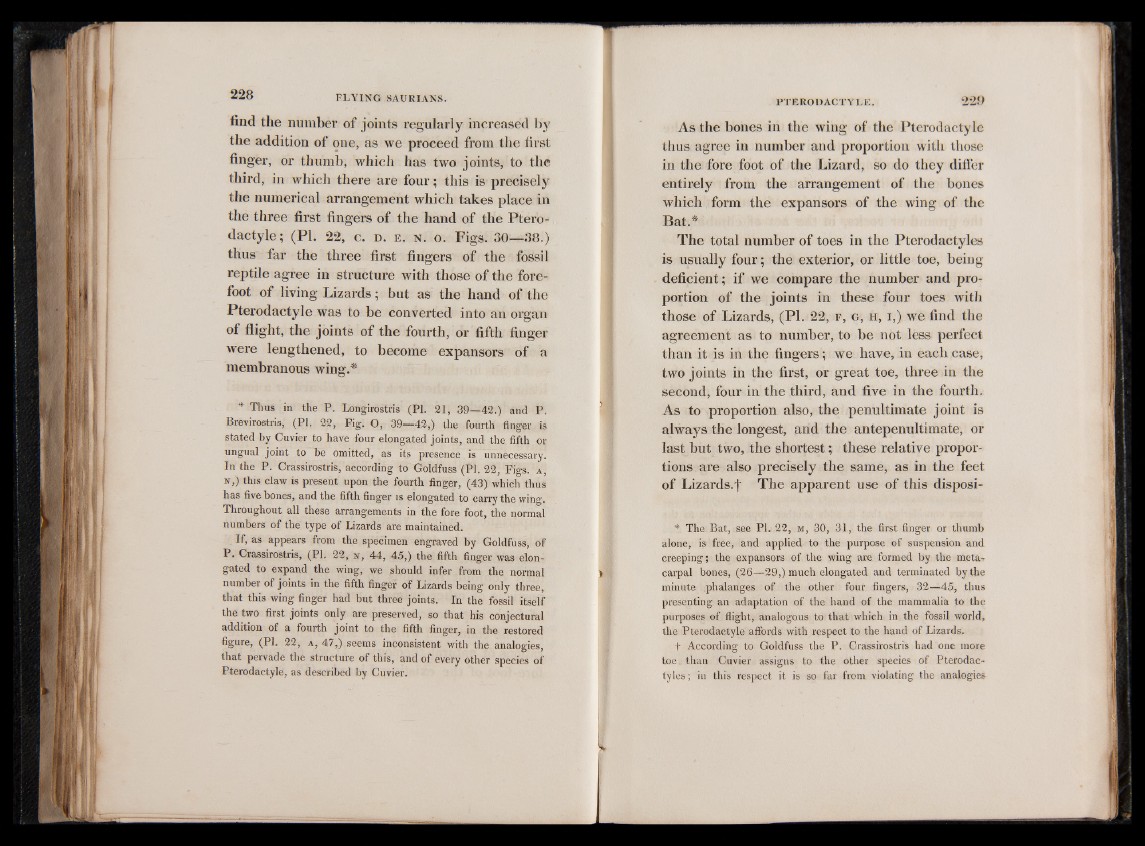
find the number of joints regularly increased by
the addition of one, as we proceed from the first
finger, or thumb, which has two joints, to the
third, in which there are four ; this is precisely
the numerical arrangement which takes place in
the three first fingers of the hand of the Ptérodactyle
; (PI. 22, c. d. e . n . o. Figs. 30— 38.)
thus far the three first fingers of the fossil
reptile agree in structure with those of the forefoot
of living Lizards ; but as the hand of the
Ptérodactyle was to be converted into an organ
of flight, the joints of the fourth, or fifth finger
were lengthened, to become expansors of a
membranous wing.*
* Thus in the P. Longirostris (PI. 21, 39—42.) and P.
Brevirostris, (PI. 22, Fig. O, 39—42,) the fourth finger is
stated by Cuvier to have four elongated joints, and the fifth or
ungual joint to be omitted, as its presence is unnecessary.
In the P. Crassirostris, according to Goldfuss (PI. 22, Figs, a ,
n ,) this claw is present upon the fourth finger, (43) which thus
has five bones, and the fifth finger is elongated to carry the wing.
Throughout all these arrangements in the fore foot, the normal
numbers of the type of Lizards are maintained.
If, as appears from the specimen engraved by Goldfuss, of
P. Crassirostris, (PI. 22, x , 44, 45,) the fifth finger was elongated
to expand the wing, we should infer from the normal
number of joints in the fifth finger of Lizards being only three,
that this wing finger had but three joints. In the fossil itself
the two first joints only are preserved, so that his conjectural
addition of a fourth joint to the fifth finger, in the restored
figure, (PI. 22, a , 47,) seems inconsistent with the analogies,
that pervade the structure of this, and of every other species of
Ptérodactyle, as described by Cuvier.
As the bones in the wing of the Pterodactyle
thus agree in number and proportion with those
in the fore foot of the Lizard, so do they differ
entirely from the arrangement of the bones
which form the expansors of the wing of the
Bat.*
The total number of toes in the Pterodactyles
is usually four; the exterior, or little toe, being
deficient; if we compare the number and proportion
of the joints in these four toes with
those of Lizards, (PI. 22, f , g, h , i ,) we find the
agreement as to number, to be not less perfect
than it is in the fingers; we have, in each case,
two joints in the first, or great toe, three in the
second, four in the third, and five in the fourth.
As to proportion also, the penultimate joint is
always the longest, and the antepenultimate, or
last but two, the shortest; these relative proportions
are also precisely the same, as in the feet
of Lizards.)' The apparent use of this disposi-
* The Bat, see PI. 22, m, 30, 31, the first finger or thumb
alone, is free, and applied to the purpose of suspension and
creeping ; the expansors of the wing are formed by the metacarpal
bones, (26—29,) much elongated and terminated by the
minute phalanges of the other four fingers, 32—45, thus
presenting an adaptation of the hand of the mammalia to the
purposes of flight, analogous to that which in the fossil world,
the Pterodactyle affords with respect to the hand of Lizards.
f According to Goldfuss the P. Crassirostris had one more
toe than Cuvier assigns to the other species of Pterodactyles
; in this respect it is so far from violating the analogies